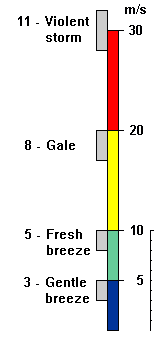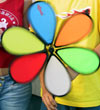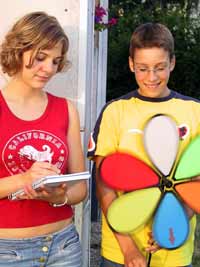
> English > Climate Encyclopaedia > Climate in Cities > basics > 2. Urban Climate > * Worksheet 1
|
|
 |
Climate in cities
Basics |
2. Urban climate
Wind in the city
Worksheet 1: Measurement of wind
|
1. Measurement of wind speed
Wind is defined as the movement of air and the wind speed gives the distance the air travels in a certain time.
Typical measurements of wind speed are:
- metres per second (m s-1),
- kilometres per hour (km h-1)
- miles per hour (mph).
A helpful website about wind speed (including a wind speed-converter e.g. from m s-1 into km h-1) can be found the Icelandic Meteorological Office web site: www.vedur.is/english/wind_eng.html
|
wind speed
in m s-1 |
description |
|
> 30 |
extreme wind, dangerous |
|
20-30 |
very windy, caution is advised |
|
10-20 |
considerable wind, may
lead to difficulties |
|
5-10 |
rather slow wind |
|
< 5 |
very slow wind | |
|
|
|
|
 |
 |
 |
|
1. Windscale, author: Icelandic Meteorological Office, Reykjavik.
|
|
2. Wind speed in Cities:
Chicago in the USA is known as "the Windy City".
- Find out what the average annual wind speed of Chicago is!
- Is it correct to call Chicago "the Windy City"? Discuss!
- Find out where and when the wind speed was or is still extremely high.
The following links will help you:
- www.cityofchicago.org/DPD/ChgoFacts/Climate.html
- www.aws.com/aws_2001/schools/wx_mania/WNCWeatherManiaNovember
222002.html
- www.census.gov/pubinfo/www/radio/pa0412.htm
- http://classroom.aws.com/main.asp
You can login at any American school and check the weather! Click “Tools” and then map gallery and you will find an overview of American wind speeds, temperatures etc. at different places! The “meteorology match game” and “extreme weather” are also worth clicking on!
|
3. Experiment: Is your hometown also a windy city?
There are 3 ways to measure wind speed:
- using a wind sock - this only shows whether the wind speed is high or low.
- using a pinwheel - this allows comparison of wind speeds at different places
- using an anemometer - this instrument is used by meteorologists to measure wind speeds accurately, ask your physics teacher whether your school has one of these.
In this experiment you will use a pinwheel to help you find out whether your hometown is also a "windy city".
|
You will need:
- a pinwheel with pointer
- a stopwatch
- a piece of paper to record your measurements on (see below)
Prepare the equipment:
- fix the pointer (a paper arrow) to the pinwheel (see the photograph opposite)
Aim of experiment:
- To compare the wind speed at different locations by measuring how many turns the pinwheel makes in a certain time.
|
 |
 |
 |
|
2. Pinwheel with pointer.
Photograph: Julia Heres.
|
|
 |
 |
|
3. Measurement of windspeed.
Photograph: Julia Heres.
|
|
 |
a) Make sure your pointer is fixed onto one of the wings of the pinwheel.
b) Record how many times your pinwheel turns in one minute by counting how often the pointer passes the bottom in 60 seconds.
c) Write down the number of turns the pinwheel makes and the place where you made the measurement.
d) Go to another place and do the measurement again. Compare your results from the two places. Which place was the windiest?
|
|
Compare the wind speeds at corners of roads with those on wide streets and on narrow streets! What differences do you see?
If you have an anemometer at your school, take it with you and measure the real windspeed as well.
|
Experiment: Comparison of wind speeds |
|
Name: |
Date: |
|
Time: |
Place: |
Turns per minute: |
Interpretation |
|
8:00 a.m. |
Kensington Road |
34 |
more windy than .... |
| ... |
... |
... |
... |
| ... |
... |
... |
... | |
|
|
|
|
About this page:
authors: Dr. Helmut Schrettenbrunner and Dr.Yvonne Schleicher - University of Nürnberg, Germany
educational reviewing: Julia Heres - University of Nürnberg, Germany
last update: 2003-09-09
|
 > English > Climate Encyclopaedia > Climate in Cities > basics > 2. Urban Climate > * Worksheet 1
> English > Climate Encyclopaedia > Climate in Cities > basics > 2. Urban Climate > * Worksheet 1


